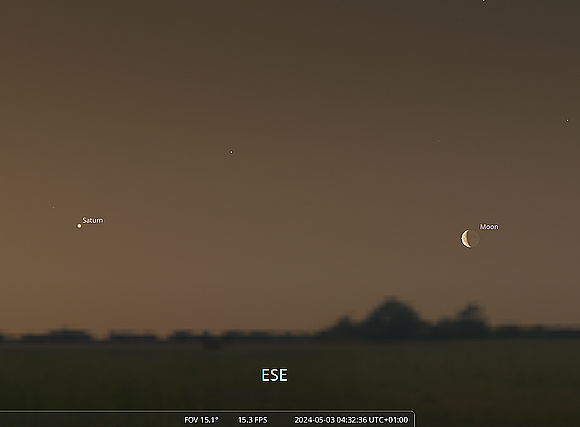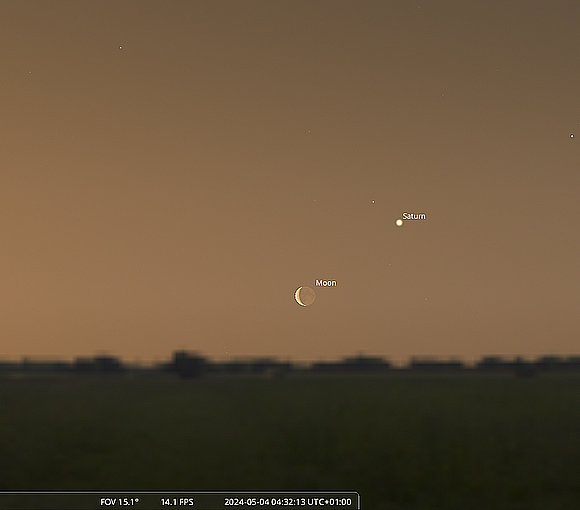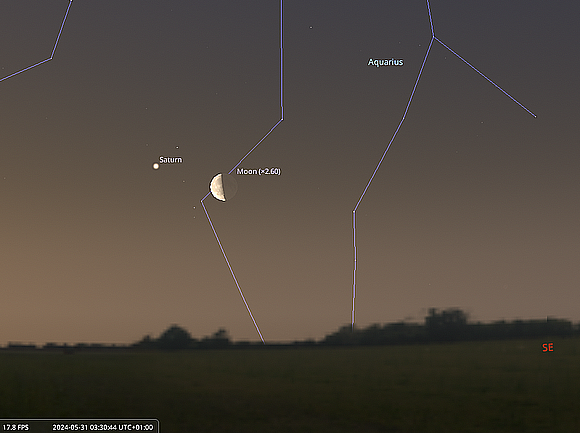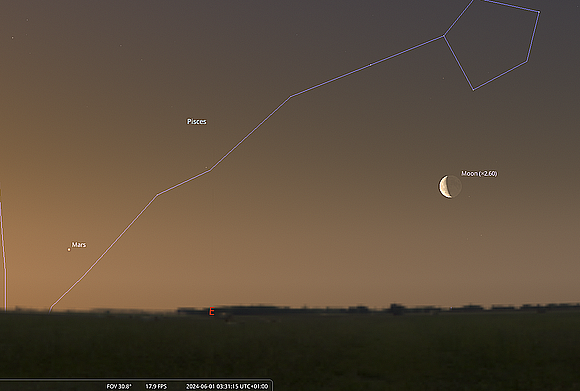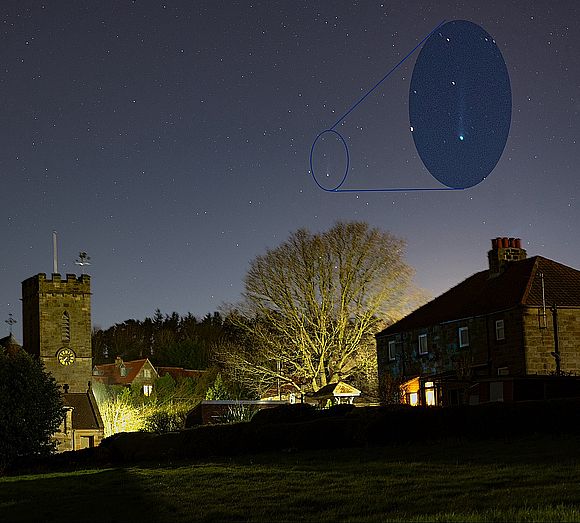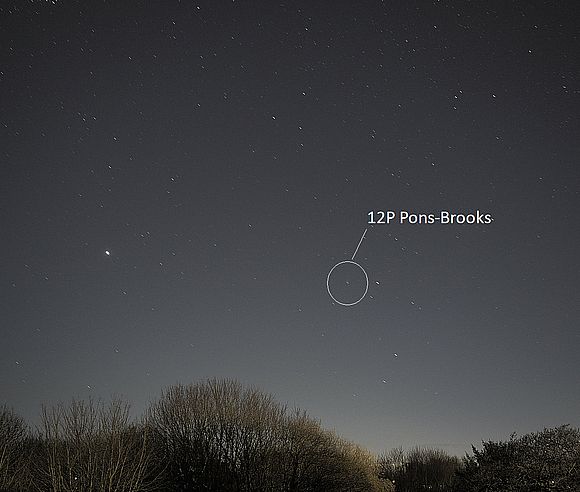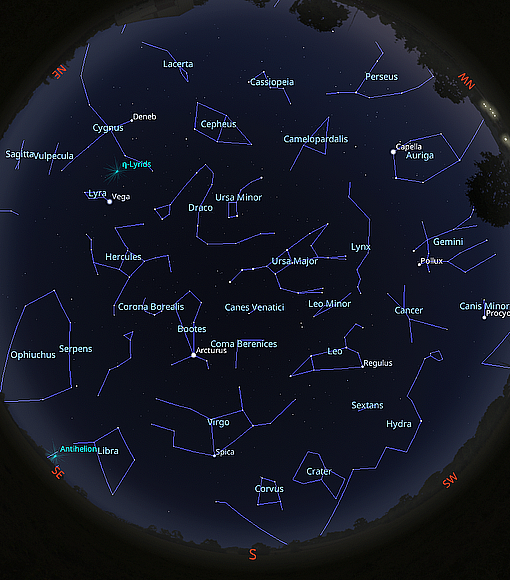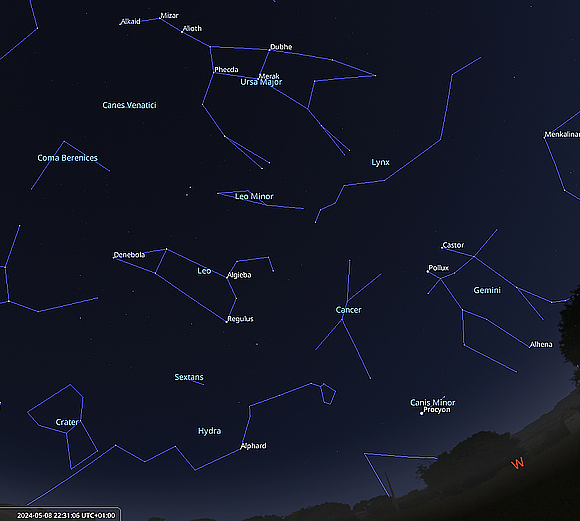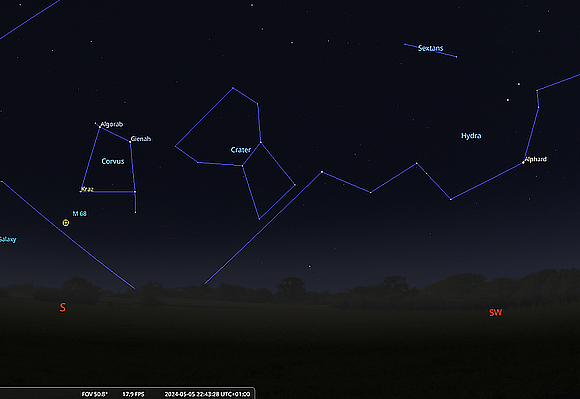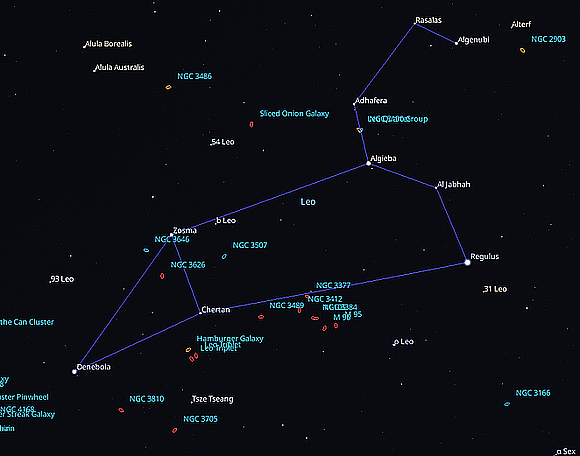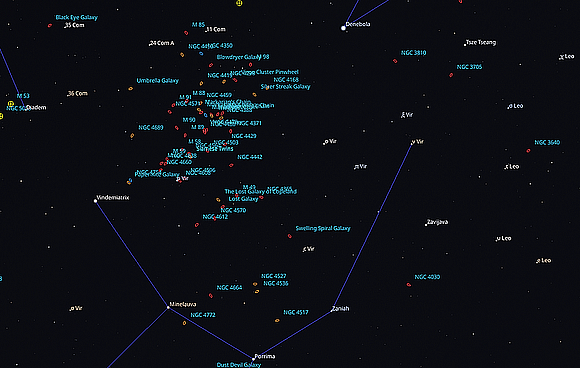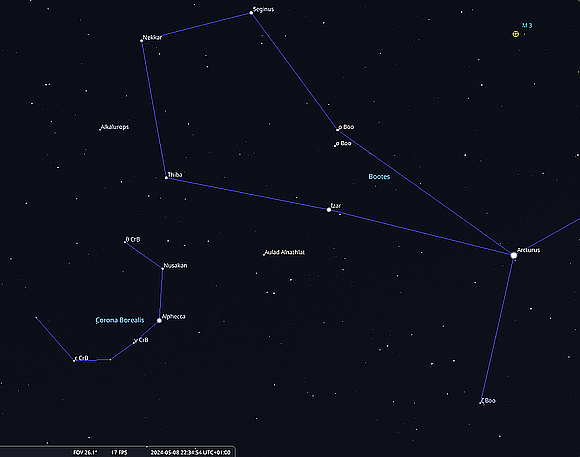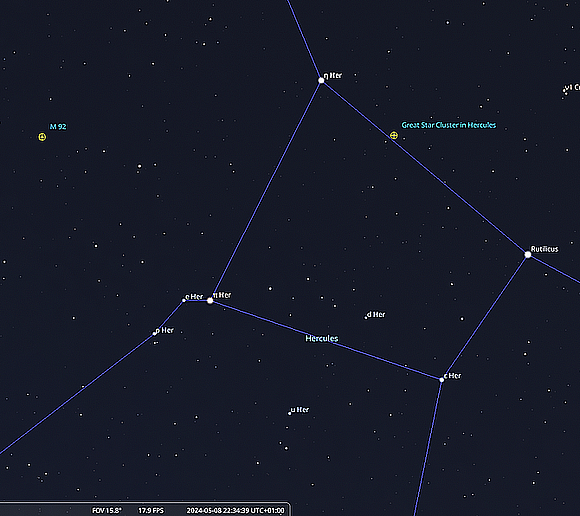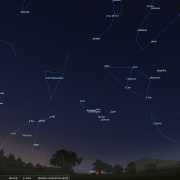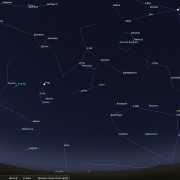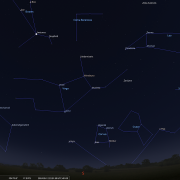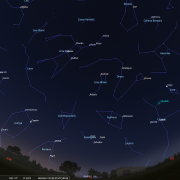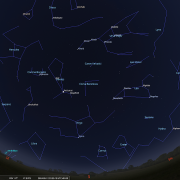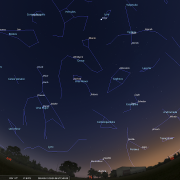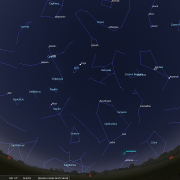In this month's Sky Notes:
Planetary Skylights: A Brief Guide to April's Night Sky
May is a very quiet month for planetary observation this year, with most still close to the Sun or, only just pulling away from its glare in the dawn sky. I suspect most observers (unless they make a special effort) will not notice a planet until at least late July, dawn ariving so early from our latitude, and dusk so late!
 Saturn is very slowly drawing away from the Sun in the early dawn sky but will not be apparent in ‘darker’ skies until near the end of May, rising shortly before 03:00hrs from UK latitudes. There will be a limited observing window to catch Saturn, lying just 6 degrees above the ESE horizon at the start of May and double this by the months end, before growing dawn twilight overtakes it.
Saturn is very slowly drawing away from the Sun in the early dawn sky but will not be apparent in ‘darker’ skies until near the end of May, rising shortly before 03:00hrs from UK latitudes. There will be a limited observing window to catch Saturn, lying just 6 degrees above the ESE horizon at the start of May and double this by the months end, before growing dawn twilight overtakes it.
Observations with a telescope will therefore be restricted, improving only slowly for northern hemisphere observers who will note the rings are little more than 2 degrees open in tilt. Should you be a very early riser, on May 3rd, Saturn resides 11 degrees left of a waning crescent Moon, and above right the following morning. Observe around 04:30hrs BST. At the very end of the month the Moon again joins Saturn, look for them at 03:30hrs BST on the 31st less than 4 degrees apart, low in the ESE.
 Mars is the only other planet visible in the dawn sky, the same visibility and observing criteria applying to it as Saturn, except Mars is fainter and further to the east - closer to the Sun's glare. Even by the start of June it is still languishing just above the horizon, and will be several months before observing circumstances take a turn for the better. The waning Moon lies 15 or so degrees to the right of Mars on June 1st at 03:30hrs BST.
Mars is the only other planet visible in the dawn sky, the same visibility and observing criteria applying to it as Saturn, except Mars is fainter and further to the east - closer to the Sun's glare. Even by the start of June it is still languishing just above the horizon, and will be several months before observing circumstances take a turn for the better. The waning Moon lies 15 or so degrees to the right of Mars on June 1st at 03:30hrs BST.
May Meteors
The Eta Aquarid meteor shower is this month's best offering, with peak activity falling in the predawn hours of May 6th. The shower's radiant is quite low for UK observers, with Aquarius only just rising in the early morning hours at this time of year. Observed rates would otherwise be considerably higher (ZHR of 25-30) instead of the 10-12 per hour normally visible. Eta Aquarids is one of two meteor showers associated with debris particles deposited over time by comet Halley, the other shower being the Orionids seen in late October. View to the east, south, and high to the southeast around 03:00hrs and you should hopefully spot a few bright examples. Moonlight will be absent.
Comet 12P Pons-Brooks
We have now lost sight of comet 12P Pons-Brooks from the UK, setting before it becomes dark and rising well after sunrise. At the start of April, if you knew exactly where to look on a given date, the comet was just about visible to the naked eye, but only from very dark locations. It was however a relatively easy binocular object. During the recent total solar eclipse visible from the US, observers did try to spot it with the naked eye, but, alas were unsuccessful, the comet visible only when imaged. We have a few images taken by WDAS members, nothing too startling, but given the succession of cloudy evenings for UK observers at the end of March/start of April when Pons-Brooks was at its best, it is almost a miracle we have anything to show for the comet's return, the next one not until 2095!
As the eye would almost see - comet 12P April 1st - low to the west. Image - M Dawson
(Click for full image)
Finally in this segment, the end of May is normally the start of the Noctilucent cloud season (more on this next month), so do keep a watch post 23:00hrs for any blue filamentary cloud structures above the northern horizon. Also, with the Sun nearing the peak of its current solar cycle and increasingly active, be aware of any aurora alerts - and hope nocturnal cloud cover is minimal!
May Night Sky
Following on from a dire winter observing offering (cloud, wind, and rain), spring has so far been little better, recent conditions being more akin to those associated with winter! Still, we live in hope matters will improve for the better! That said, astronomical twilight will soon be absent from UK latitudes until early August, the lighter nights curtailing observational activity the deeper we head through May. Constellation recognition becomes increasingly tricky with a viable observing window of little more than 3 hours by the month's end.
The last vestiges of seasonal winter constellations are lost to bright twilight, Canis Minor and Gemini highlighted by the stars Procyon, Castor, and Pollux respectively, last to depart in the west. The circumpolar ‘winter’ star, Capella in the constellation of Auriga, located in the NW dipping down in readiness for its 'summer holiday', skirting above the N horizon.
All, however, is not lost for the 'star gazer' and by utilising the brighter stars visible and certain star patterns, an observer may still navigate around the night sky. For instance, the familiar Plough or Big Dipper asterism forming the hindquarters of Ursa Major - the Great Bear, is located almost overhead during May. Follow the natural sweep of 3 stars in the handle of the Plough and ‘arc to Arcturus’, the brilliant amber star in Boötes located high in the SSE. Flatten this curve out and then 'speed on to Spica' - chief star in Virgo located down in the south.
Lower right of Spica, note the faint outline of Corvus the Crow, a constellation sometimes known as 'Spica's spanker', referencing the type of sail this outline suggests. To the right of Corvus perpetually out of reach, sits the bird's drinking cup, Crater. These two less prominent, but distinctive star groups ride upon the coils of Hydra - the water snake, the largest constellation in the heavens, which sprawls above the horizon from SE to SW and only just visible in its entirety during the first few weeks of May from the UK.
The water snake's lead star; Alphard - the Lonely One, resides in the SW, its amber lustre conspicuous amongst its sparse stellar surroundings. Hydra contains 3 Messier objects, M83, also known as the Southern Pinwheel Galaxy, located on the border of Hydra and Centaurus, M68 is a globular cluster not far from M83, and M48, another open star cluster at the western end of the serpent, near the border with Monoceros already setting in the west by the time skies fall semi-dark.
Higher in SSW stands Leo, the spring skies signature constellation, identified by the ‘sickle’ asterism, a stellar arrangement highlighted itself by Regulus, least brilliant of those 1st magnitude stars visible in the night sky. The 'sickle' asterism, so named because it resembles the outline of that farming implement, looks like a backwards question mark emanating from Regulus. The hindquarters of Leo are marked by a triangular arrangement of stars with the star Denebola marking the rear point.
Not far below the star, Chertan or Chort within the triangle, lie several galaxies including M65 and M66, as well as NGC 3628. Further west (roughly 2/3rds of the way from Denebola to Regulus) resides another group of galaxies comprised of M95, M96 and M105. All may be glimpsed in a decent 100mm (4") telescope.
In the area of sky behind Leo and above Virgo, a smattering of faint naked eye stars mark Coma Berenices, a constellation rich in deep sky objects (galaxies mostly). These include the messier objects M53, (a globular cluster) M64, M85, M88, M91, M98, M99 and M100 (all galaxies) as well as the Coma galaxy cluster, some 300 million light years distant.
Virgo itself is the largest zodiac constellation and contains many deep sky objects (see in focus - Window on the Wider Universe and Spring Tales) The constellation occupies much of the aspect above the southern horizon during May, its outline somewhat resembles a bowl with a crooked leg (a bit like a distorted ‘Y’ pattern). Above the bowl of the 'Y' many galaxies belonging to the Virgo cluster can be identified in amateur scopes. The whole region of sky bounded by the 'bowl', Coma and the hindquarter of Leo is often referred to as the 'realm of the galaxies', being a window onto the wider universe, well away from intervening galactic gas and dust. Messier galaxies alone within Virgo number eleven; M49, M58, M59, M60, M61, M84, M86, M87, M89, M90 and M104 - the Sombrero galaxy. Should insomnia strike when nights are clear in May, see how many 'fuzzies' you can track down in a telescope.
Later in the month - or night, the Scales, or Balance of Libra marks the forward boundary of seasonal summer constellations, especially those located on the ecliptic. The ancient Greeks called the stars we now associate as Libra the Chelae, or “claws,” and were considered once as being part of Scorpius. The constellation's brightest stars; Zubeneschamali and Zubenelgenubi have names derived from Arabic phrases meaning 'northern claw' and 'southern claw' respectively. Note the bright orange hue of Antares chief star in Scorpius low to the SSE late in May shortly after 23:30hrs. More to be said on these groups next month, as to the large, but faint constellations covering much of the SE aspect above the horizon; Ophiuchus, Serpens, and Hercules often overlooked during the short light nights of late May, June, and July, but rich in DSO's.
Return now to brilliant Arcturus at the base of the constellation Boötes, the outline of which reminds somewhat of a 'thin kite'. Arcturus is visually the 4th brightest star in the heavens, and only surpassed by Sirius from UK shores and therefore for over 8 months of the year, is the brightest star visible at mag -0.05. Arcturus is the closest example of an orange giant star, just under 37 light years away, and now aged 7 billion years was once very like our own Sun. Arcturus has the largest proper motion (real motion through space) of any bright star, a rate of 2 arc-seconds per year, cutting across our Sun's trajectory as it orbits around the galaxy. In less than half a million years a telescope will be required just to spot it at all.
Eastwards of Boötes lies the distinctive circlet of stars marking Corona Borealis - the Northern Crown, said to represent the golden crown worn by Princess Ariadne of Crete when she married the god Dionysus (Roman god Bacchus) and made by Hephaestus, the god of fire. The constellation is appreciated best at very low powers. The centre star in the tiara is known as Alphecca or Gemma.
The great hero Hercules follows the crown, a large, ill-defined constellation that contains no bright stars and is best identified by the Keystone asterism named after its shape. The constellation does however contain the wonderful globular cluster known as M13 located a third of the way down the right-hand side of the Keystone, marked by eta and zeta herculis. Another fine globular, M92 lies above the keystone stars pi and eta.
Finally, turning to the east, look for the sparkling steely blue hue of Vega in Lyra rising in the ENE after its winter flirtation with the north horizon, and accompanied in the NE lower still by Deneb in Cygnus. These circumpolar summer luminaries are now on the comeback road, the third and non-circumpolar member of the 'summer triangle', Altair in Aquila, becoming visible low to the east by mid-month. Serious deep sky observing may then be difficult and inconvenient, but if conditions are mild and clear it remains a joy just to step outside and admire the ever-changing aspect of the night sky.
May 2024 Sky Charts
Additional Image Credits:
- Planets and Comets where not otherwise mentioned: NASA
- Sky Charts: Stellarium Software and Starry Night Pro Plus 8
- Log in to post comments

